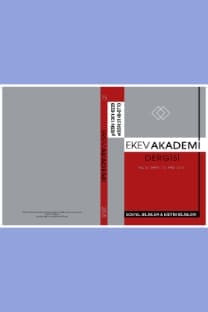THE NEW WOMAN THROUGH STRUCTURALISM IN SARAH GRAND’S THE HEAVENLY TWINS
Structuralism, Feminism, ‘New Woman’, Sarah Grand “The Heavenly Twins”.,
___
- Aksan, D. (1977). Her yönüyle dil (ana çizgileriyle dilbilim) II. Ankara: TDK 439.
- Alkan, H. (2018). George Eliot’ın Middlemarch, Sarah Grand’ın Cennetlik İkizler ve George Moore’un Esther Waters romanlarında kadının konumunun psikanalitik liberal feminizm yaklaşımıyla incelenmesi. (Yayımlanmamış doktora tezi), Ankara: Ankara Üniversitesi Sosyal Bilimler Enstitüsü.
- Barker, H. (2005). Women’s history: Britain, 1700-1850. London: Routledge.
- Barthes, R. (1972). Critical essays (R. Howard, Trans.). Evanston: Northwestern Univ. Press. (The original was published in 1964).
- Boulding, E. (1976). The underside of history, a view of women through time. Boulder: Westview Press.
- Caine, B. (1997). English feminism 1780-1980. New York: Oxford Univ Press.
- Cannon, C. (1999). The rights of medieval English women: crime and the issue of representation. In B.A. Hanawalt and D. Wallace (Ed.), Medieval Crime and Social Control (156-185). Mineapolis: Claredon Press.
- Chomsky, N. (1965). Aspects of the theory of syntax. Cambridge: The MIT Press. Culler, J. (1973). Structuralist poetics. London: Routledge & Kegan Paul Ltd.
- Çaha, Ö. (2003). Feminizm. In M. Türköne (Ed.), Siyaset (559-589). Ankara: Lotus.
- Doğramacı, E. (1992). Türkiye’de kadının dünü ve bugünü. Ankara: Türkiye İş Bankası.
- Eichenbaum, B. (1965). Russian formalist criticism: four essays (L.T. Lemon and M.J. Reis, (Trans.). Lincoln: University of Nebraska Press. (The original was published in 1925).
- French, M. (1983). Beyond power: on women, man, and morals. New York: Ballantine Books.
- Gies, F. (1980). Women in the Middle Ages. New York: Barnes and Noble.
- Grand, S. (1992). The Heavenly Twins. Ann Arbor: University of Michigan Press.
- Greimas, A. J. (1983). Structural semantics: an attempt at a method (D. McDowell, R. Schleifer and A. Velie, Trans.). Lincoln: University of Nebraska Press. (The original was published in 1966).
- Hawkes, T. (1989). Structuralism and semiotics. Suffolk: Routledge.
- Jakobson, R. (1971). Fundamentals of language. Paris: Mouton.
- Kayahan, F. (1999). Feminizm. İstanbul: BDS.
- Lane, M. (1970). Structuralism: a reader. New York: Basic Books.
- Leach, E. (1973). Claude Levi-Strauss. New York: The Viking Press.
- Levi-Strauss, C. (1963). Structural anthropology (C. Jacobson and B.G. Schoepf, Trans.). New York: Basic Books Inc. (The original was published in 1958).
- Mangum, T. (1998). Married, middlebrow, and militant: Sarah Grand and the new woman novel. Ann Arbor: The University of Michigan Press.
- Michel, A. (1993). Feminizm (Çev. Ş. Tekeli). İstanbul: İletişim. (Eserin orijinali 1979’da yayımlandı).
- Mill, J. S. (1869). The subjection of women. London: Longmans, Green, Reader, and Dyer.
- Mohl, R. (1933). The three estates in Medieval and Renaissance literature. New York: Columbia University Press.
- Pettit, P. (1975). The concept of structuralism: a critical analysis. Dublin: Gill and Macmillan.
- Propp, V. (2005). Morphology of the folk tale (L. Scott, Trans.). Austin: University of Texas Press. (The original was published in 1928).
- Ramazanoğlu, C. (1998). Feminizm ve ezilmenin çelişkileri (Çev. M. Bayatlı). İstanbul: Pencere Yayınları. (Eserin orijinali 1989’da yayımlandı).
- Saussure, F. (1976). Genel dilbilim dersleri-I (Çev. B. Vardar). Ankara: TDK. (Eserin orijinali 1916’da yayımlandı).
- Showalter, E. (1993). Daughters of decadence: women writers of the Fin-de-Siecle. New Brunswick: Rutgers UP.
- Taylor Mill, H. (1994). The enfranchisement of women. In A.P. Robson and J.M. Robson (Ed.), Sexual Equality: Writings by John Stuart Mill, Harriet Taylor Mill and Helen Taylor (178-203). Toronto: University of Toronto Press.
- Wollstonecraft, M. (1988). A vindication of the rights of women. New York: W.W. Norton and Company.
- ISSN: 1301-6229
- Yayın Aralığı: 4
- Başlangıç: 1996
- Yayıncı: ERZURUM KÜLTÜR VE EĞİTİM VAKFI
UZAKTAN EĞİTİM SÜRECİNDE ÖĞRENMENİN SÜRDÜRÜLMESİNE İLİŞKİN ÖĞRETMEN GÖRÜŞLERİ
Tuba AYDIN GÜNGÖR, Çiğdem ÇAKIR
ASKERİ MOTİVASYONDA MÜZİĞİN ÖNEMİ
OKUL ÖNCESİ KURUM YÖNETİCİLERİ VE VELİ GÖRÜŞLERİ IŞIĞINDA OKUL ÖNCESİNDE DİN EĞİTİMİ
TÜRKİYE’DE DOLAYLI VERGİ VE EKONOMİK BÜYÜME İLİŞKİSİ: ARDL SINIR TESTİ YAKLAŞIMI
ERZURUM’DA ANIT ESERLERE YANSIYAN TÜRK KADINI İMGESİ
Ayşegül ZENCİRKIRAN, Yunus BERKLİ
Yeşim DERSUNELİ, Özlem ÇAKMAK TOLAN
Murat SAĞLAM, Mehmet KARANFİLOĞLU
İNGİLİZCE ÖĞRETİMİNDE ÖLÇME DEĞERLENDİRME SÜRECİNE İLİŞKİN ÖĞRETMEN GÖRÜŞLERİ
